Table of Contents
- ABC link exchanges and private networks carry rising SEO risks due to increasing algorithm scrutiny and potential “bad neighborhood” associations.
- Natural, relevant link exchanges may still be safe, especially when paired with high-quality, human-written content on authoritative sites.
- Avoid buying links from shared spreadsheets or low-traffic, high-DR domains, which are often algorithm targets post-Helpful Content and Spam Updates.
- The safest outreach tactics offer genuine value first, via post mentions, authentic usage, or valuable stats, and avoid a transactional tone.
- Diversifying link strategies (digital PR, content-led outreach) remains the most reliable approach in a volatile SEO landscape.
I’ll admit that when I was freelancing, someone asked me to do some ABC link exchanges for them, and I embarrassingly told them I didn’t know how. (I didn’t even know what the term was.)
Hopefully, this reflected my sole focus and experience on building backlinks naturally vs my naivety, though it was perhaps a little of both.
So, I was determined to learn everything I could about them.
Over the years, this tactic has grown in popularity as SEOs and agencies have built private Slack communities, Facebook groups, and other networks to essentially “trade” backlinks.
Since this strategy has been exploited to death, its quality and effectiveness are questionable.
In this post, I’ll pull back the curtain and help you determine exactly how, when, and if you should consider link exchanges.
What Are Link Exchanges?
Link exchanges or link swaps are a popular link building tactic. Essentially, you link to a website, and they link back to you.
There are a few different types:
One-to-One Link Exchanges
If you’ve worked in the digital marketing space (especially SaaS) I’m sure you’ve seen an email like this:

When someone links to you and you link back, these links are also known as reciprocal links.
Ahrefs did a fantastic analysis of reciprocal linking to find that over 43% of top-ranking sites in their study had some reciprocal links.
But does this mean these reciprocal links were all link exchanges?
Most likely not.
Reciprocal linking happens very naturally throughout the web. For instance, we link to Ahrefs in a lot of our posts because it is an integral tool for link builders and digital PRs.
In fact, Google seems to understand that this occurs both naturally and purposefully. That is why they mention in their link spam guidelines that “excessive link exchanges” are against their policies, not all link exchanges.
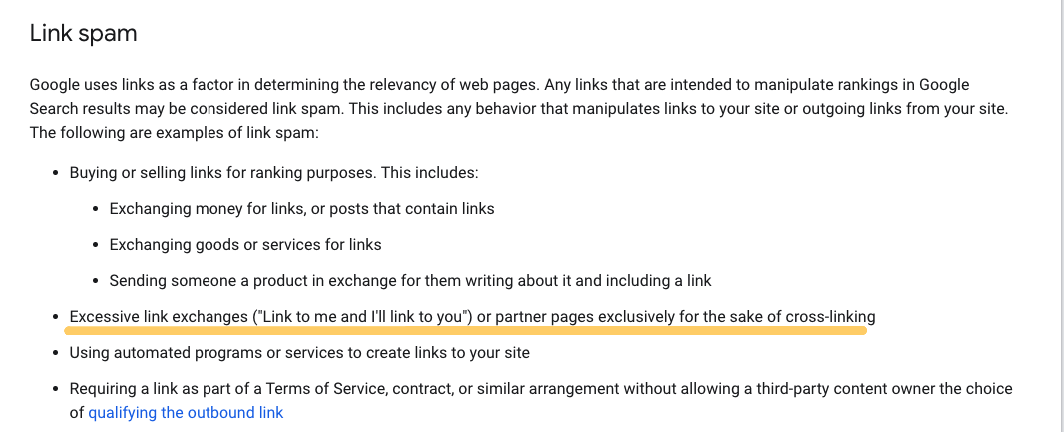
However, there are only so many one-to-one link exchanges that you can do before Google will deem it excessive.
So, savvy SEOs have come up with a way to somewhat obfuscate the trail so it’s not as obvious for Google’s algorithm to pick up.
ABC Link Exchanges
The ABC link exchanges are when three or more sites link to each other.
A links to B, B to C, and C to A.
Everyone gets a link, and Google is none the wiser…right?
Not exactly.
Vast networks of ABC link exchanges exist on the web. There are link builders who have built relationships with sites just to keep the door open for link exchanges in the future.
And while this is smart and can be effective, some risk is still involved.
The main risk is what Brian Dean called “bad neighborhoods” in our podcast. He was talking about buying links, but the same risk applies here.
Most ABC link exchanges have strict guidelines as to the kinds of sites they let in.
…what happens is a lot of times they’re like, “no gambling, crypto, CBD, blah,” to make it seem kind of legit. And then they eventually allow like a borderline one and then it’s a free for all.
And then your link is all of a sudden goes from like, Oh, this is really nice link to like on a spammy site with bad neighborhoods as I used to call it.”
So, essentially you are banking on the sites that you exchange with will maintain solid SEO best practices. Otherwise the value becomes moot.
One way that link builders try to mitigate this is with private networks.
Link Exchanges Within Private Networks
Some groups on platforms like Facebook and Slack exist online for companies to share links.
The kinds of exchanges that occur in these private networks are one-to-one, ABC, and sometimes even larger.
They are typically private groups that invite specific members or sites that meet specific criteria.
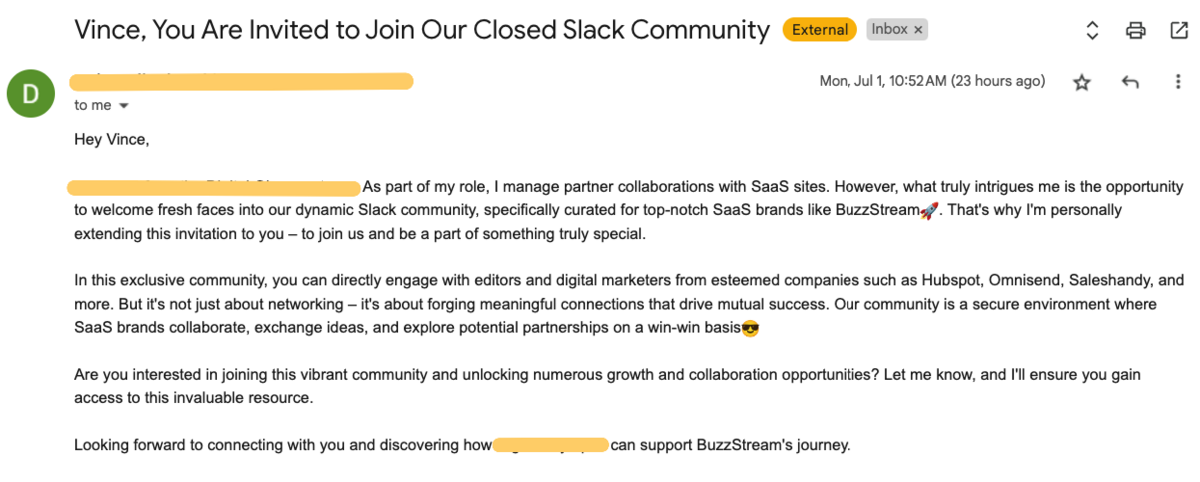
Some are free, and some are paid.
For instance, this one offers a $100 fee or payment in “links”.

I believe this type of practice causes a lot of these types of networks to be less valuable than they seem.
When pressed to find a spot for a link, then it becomes less natural.
And less natural links become easier for the algorithm to spot.
Do Link Exchanges Help SEO?
Link exchanges can help build links from highly authoritative, relevant sites if done well. Numerous link building statistics and studies have shown sites with more links have been highly correlated with more organic traffic and higher rankings.
However, our analysis of the 50 best SaaS backlink builders found that many sites that were potentially engaged in link exchanges are penalized by the June Link Spam update.
It’s fairly challenging to isolate and compare the impact of a single kind of link building.
(You would need to have a large group of sites with very similar content and build a similar link profile naturally vs through link exchanges. It would take a lot of time and resources.)
The fact is, no one should rely on one single strategy or tactic for link building.
All it takes is a single algorithm change to wipe out one tactic’s effectiveness completely.
Diversification is the key to success and the only way to mitigate the inherent risks.
With that said, let’s talk about how to exchange backlinks safely.
How to Safely Exchange Backlinks
As you can tell, I’m a little anti-link exchange in the same way that I am anti-link buying. I dislike link exchanges because I know they are exploited and, therefore, carry risks.
That said, I’ve definitely exchanged links if the opportunity is a natural fit.
Here’s how to evaluate if it’s safe to exchange backlinks.
Check the Quality of the Site
The site’s quality tells if your link will matter.
You’ll want to do both a qualitative and quantitative check.
My go-to check for quantitative metrics are:
- Domain Rating above 50 (though if it’s a new site, you can be more lenient as long as you trust that they are doing the correct things)
- Monthly Organic Traffic is above 10,000
Both are metrics you can check with a tool like Ahrefs.

But these metrics don’t tell the whole story. I also want to confirm that the metrics are consistent and moving in the right direction.
For instance on BuzzStream, there is a consistent link growth (in blue) and a consistent positive growth in organic traffic (orange).
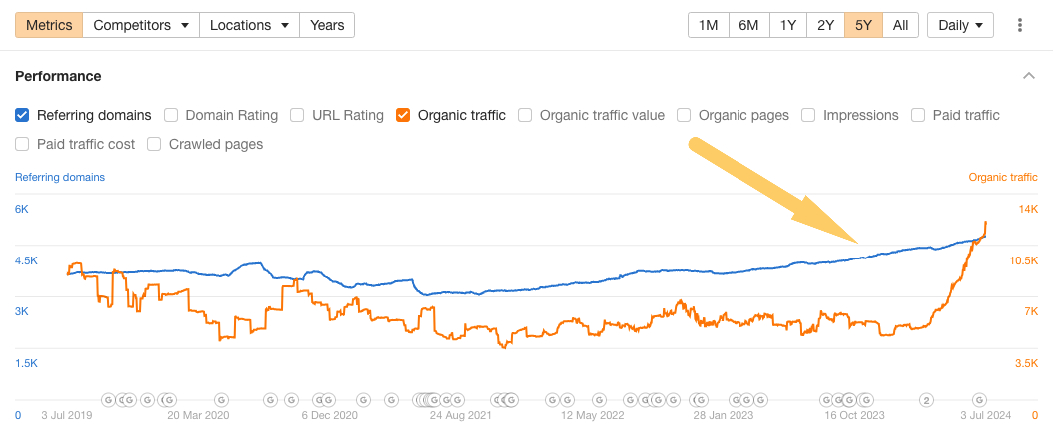
We don’t want to see dipping traffic. This signals potential SEO issues, either via algorithm change or otherwise.
For example, the site below was found on a guest posting/link insertion/link exchange spreadsheet sent to me.
It was touted as having a DR of 60 and traffic above 27k, but in the past year, the traffic has been on a downward spiral to nothing.
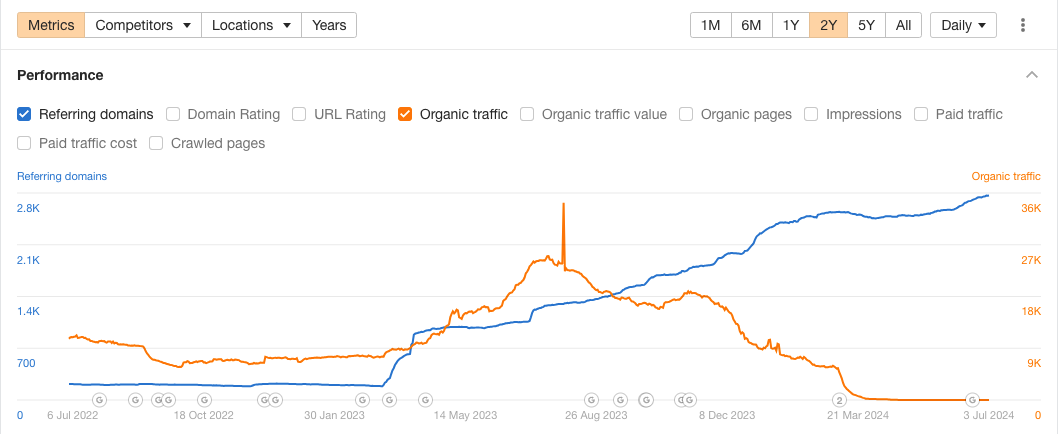
The Helpful Content Update took out a lot of these kinds of sites.
My go-to qualitative checks are:
- I run the content through Google’s Self-Assessment checklist. (Usually, if a site fails one or two, they fail them all, so I don’t get too deep into these.)
- If the content is AI-generated, I use a tool like Copyleaks AI Detector to identify and avoid sites where I think no actual effort is taken to write quality content by real people.
Check the Relevance of the Site
I’ll confirm the relevance once I know that a site is of high quality.
Essentially, the further out you get away from your core offering, the less value the link has.
For instance, BuzzStream is an email outreach tool for link builders and digital PRs.
So, I know the most relevant links I can get will be in link building, email, and PR. My customers are there, and I want to be relevant there.
If someone offered me a link from a general marketing site, that link would have some value, but not as much as a site that talks about link building specifically.
If someone offered me a link exchange from a SaaS company in the fintech space, its not valuable.
Avoid Link Networks and PBNs
The best way to avoid these is to avoid people who pitch you on behalf of others. Generally, those who reach out have a community or database of sites that they choose from to connect you to.
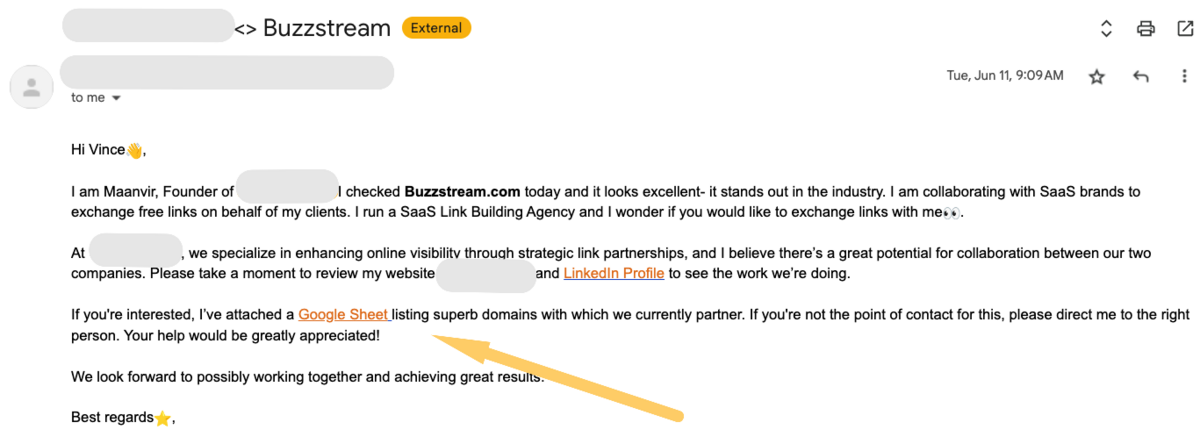
I wrote a whole post about how you shouldn’t trust the links you can get from a shared Google Sheet, and the same applies to link exchanges.
Some even say “No PBNs,” but it appears otherwise when you start to dig into the data.

As Aaron Anderson of link building agency Linkpitch.io put it in our podcast episode:
“We don’t run link exchange campaigns. I would be nervous as a site owner if I ever saw my site on a list for anything.
So from a risk perspective, I would not want to be part of like networks or lists where you could bank on me always to get a link…I would be nervous about that.
I think the smart site owners, they’re just…doing it when it makes sense. And we were really like controlling it.”
Now that we know what to look out for, let’s look at how you can actually build relationships to exchange a link.
How to Do Link Exchange Outreach
If you find a site that is a genuine match, I’ve seen three effective ways to do outreach. The direct route involves directly asking if someone wants to do a link exchange.
But to me, that’s too blatant and can be off-putting for some.
I would also use the post pitch and the indirect route (which is effectively just “mention outreach”).
Let’s dig into them.
Pitch Them a Post Idea
The most effective way to ask for an exchange is to have a post in mind (either published or not) to place the target link.
For instance, this was an effective email that I’ve received:
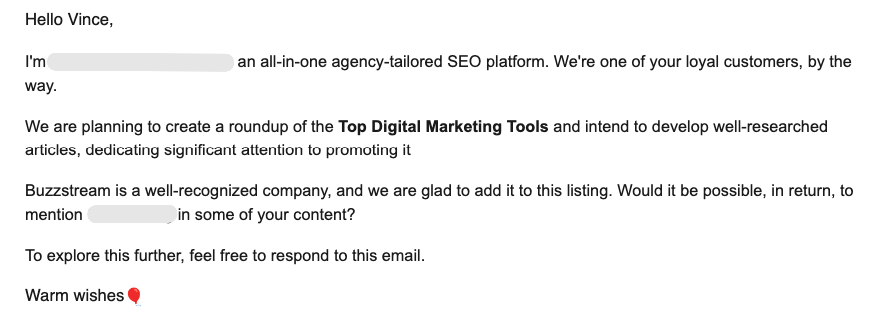
After trying out and liking their tool, I was then able to find a natural way to include it in one of my posts.
This relates to my C.H.A.M.P. Outreach Method where you are H: Helping the prospect by providing them with something of value.
In this case, you say you will include your prospect in a post.
SL: Link exchange with [Website Name]
Hi [First Name],
I’m [Your Name] from [Your Site]. We are [explain your site].
I’m writing an article about [X] and I’d like to include your site.
If at all possible, would you consider including a link to our site in one of your future publications?
Thanks,
Some link outreach I’ve seen (where applicable) sweetens the deal with a free trial or membership so the prospect can more authentically link to the site.
Remember, a link is supposed to be a vote of confidence or thumbs up.
So, if you don’t know who you are linking to, you are doing it wrong.
Mention Them in a Post (aka Mention Outreach)
In the indirect route, you have a post already written and published, and instead of directly asking them for a link exchange, you imply it.
Again, this requires that you have a post written. So some people write posts that strategically include websites in hopes that they also get a link back from them.
Or, in my case, I typically always contact people directly to let them know that I’ve included them in a post.
Then, you can ask for the link or imply.
SL: We mentioned [Website Name] in our post
Hi [Name]
I just wanted to let you know that we mentioned [Website Name] in our recent post [LINK].
Thanks again for providing (great content/tool).
We’d be thrilled if you could share it with your readers, or (even better) find a place for a link to our post in your blog.
If you can’t find a fit, no worries!
Sometimes, for most SEO-savvy marketers, what you are looking for here will be apparent, so I’ll omit the obvious ask and just say we’d be thrilled if you could share it with your readers.
A Backlink Should Never Be a Requirement
With any link exchange, the more it feels like a transaction, the more risky it is.
A link should never be “required”.
This is when link building ventures into the gray and black areas.
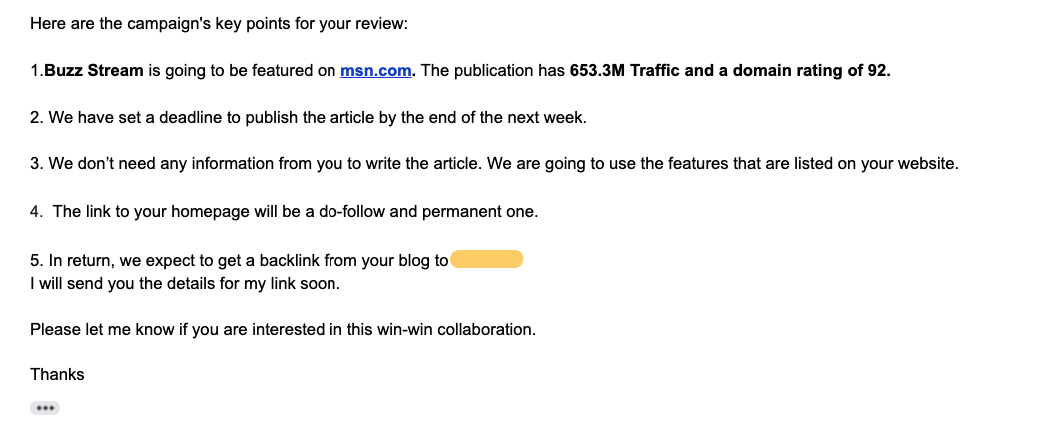
This is the exact kind of practice that leads sites and users to get hit with penalties.
Oftentimes, I hear of people who enter into a “link exchange partnership” with someone, and the other end doesn’t hold up their end of the bargain.
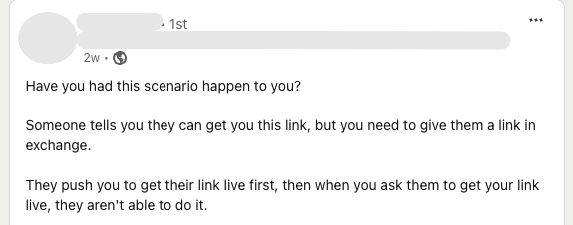
Like link buying, link exchanges take a risk assessment.
There are definitely lower-risk ways to do it, but I personally lean on tactics like digital PR, either content-led or quote pitching.
I’ve found that it has much better ROI, and although links aren’t guaranteed, you get a lot more out of it.

 End-to-end outreach workflow
End-to-end outreach workflow



 Check out the BuzzStream Podcast
Check out the BuzzStream Podcast







